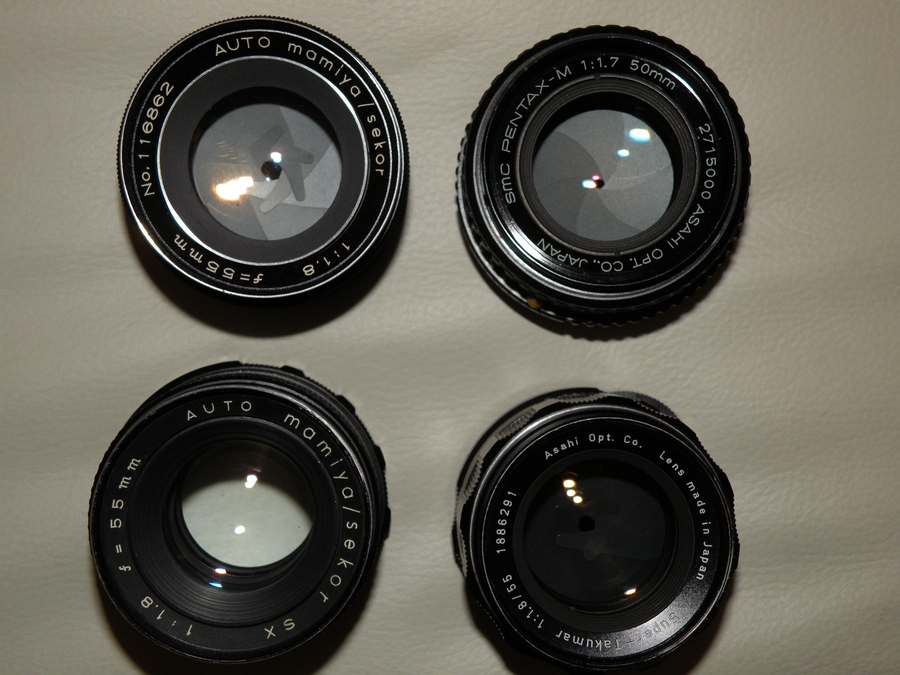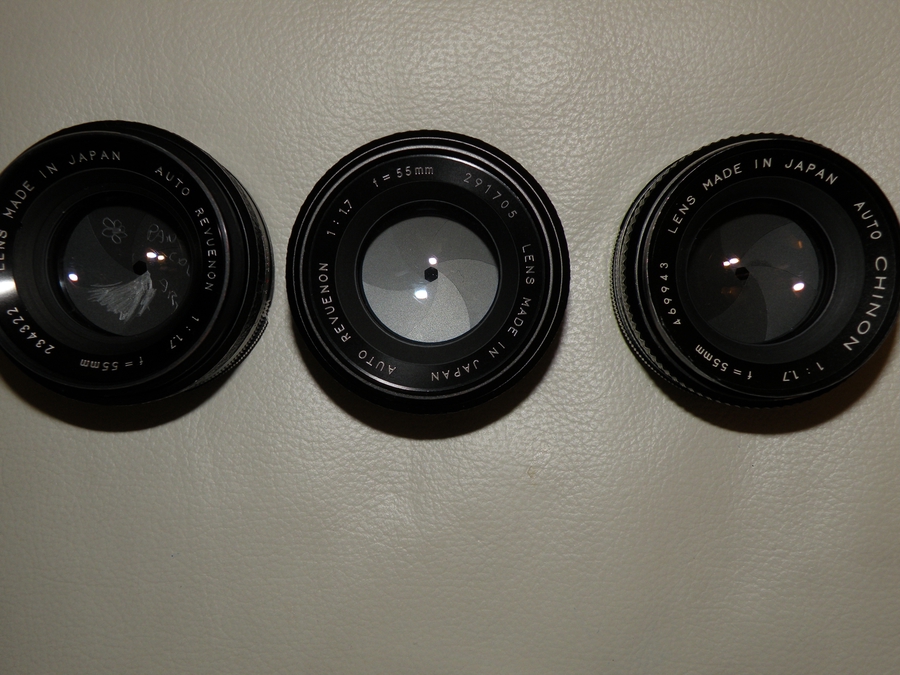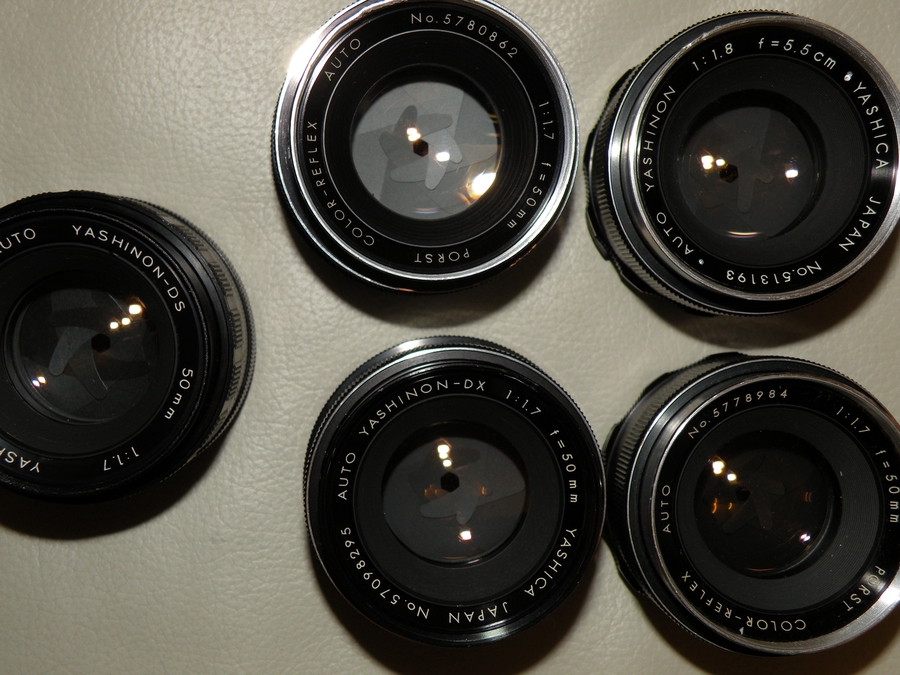| View previous topic :: View next topic |
| Author |
Message |
Pancolart


Joined: 04 Feb 2008
Posts: 3705
Location: Slovenia, EU
Expire: 2013-11-18
|
 Posted: Sun Jan 08, 2012 3:58 pm Post subject: Presenting 7x different 50(55)mm lens designs with photos Posted: Sun Jan 08, 2012 3:58 pm Post subject: Presenting 7x different 50(55)mm lens designs with photos |
 |
|
Pancolart wrote:
Trying to identify Revuenon 1.7/55mm i went and check nearly all my 1.7-1.8/50(55)mm lenses M42 + ASAHI PK 1.7/50mm.
Judging by reflections back and front 7 different designs could be separated:
First Design
Front: 6=3+3
Back: 5=1+1+2+1 (Takumar more like 1+1+3)

Second Design
Front: 6=1+2+2+1
Back: 5=1+1+2+1

Third Design
Front: 6=1+2+3
Back: 5=1+1+2+1

Fourth Design (Pancolar MC 1.8/50mm)
Front: 5=1+1+3
Back: 6=1+2+1+2
Fifth Design (Fujinon 1.6/55mm)
Front: 4=1+1+2
Back: 5=1+1+3
Sixth Design
Front: 5=1+1+2+1
Back: 5=1+1+2+1

Seventh Design
Front: 5=1+1+3 (Pentacon a bit more like 1+1+2+1)
Back: 5=1+1+3

Some amateur conclusions:
- First design and it's members surprised me  . .
- Pancolar and Fujinon F1.6 are oddballs: Pancolar having 6 rear reflections, Fujinon only 4 front.
- Chinon/Revuenon (second design) very similar to third design but having front reflections grouped differently.
- Cosinon and Petri being Pentacon variant
- There are 2 different Yashica designs used (6 front reflection - third design and 5 front reflections - sixth design)
- 50mm or 55mm doesn't play much role
I didn't dare naming the designs but perhaps you identify them with help of No-X scheme http://h9.abload.de/img/lens_scheme_dgv1axjw.png
Please let me know if i made any mistake and compare this findings with your own lenses to verify.
_________________
---------------------------------
The Peculiar Apparatus Of Victorian Steampunk Photography: 100+ Genuine Steampunk Camera Designs https://www.amazon.com/dp/B0B92829NS |
|
| Back to top |
|
 |
Excalibur


Joined: 19 Jul 2009
Posts: 5017
Location: UK
Expire: 2014-04-21
|
 Posted: Sun Jan 08, 2012 4:55 pm Post subject: Posted: Sun Jan 08, 2012 4:55 pm Post subject: |
 |
|
Excalibur wrote:
Well all interesting and maybe confusing esp in the link as you would think all the lenses in a group would be equal e.g. Zeiss macro planar 60mm f2.8 should give similar results in quality compared to a Pentacon 50mm f1.8 or Helios 44 58mm f2, in the Biotar/Xenon group.  So I suppose you can have a top lens design/construction but if you use bottle glass and assemble on a Friday afternoon. they are going to be different So I suppose you can have a top lens design/construction but if you use bottle glass and assemble on a Friday afternoon. they are going to be different 
_________________
Canon A1, AV1, T70 & T90, EOS 300 and EOS300v, Chinon CE and CP-7M. Contax 139, Fuji STX-2, Konica Autoreflex TC, FS-1, FT-1, Minolta X-700, X-300, XD-11, SRT101b, Nikon EM, FM, F4, F90X, Olympus OM2, Pentax S3, Spotmatic, Pentax ME super, Praktica TL 5B, & BC1, , Ricoh KR10super, Yashica T5D, Bronica Etrs, Mamiya RB67 pro AND drum roll:- a Sony Nex 3
.........past gear Tele Rolleiflex and Rollei SL66.
Many lenses from good to excellent. |
|
| Back to top |
|
 |
Ymmot

Joined: 24 Sep 2011
Posts: 168
|
 Posted: Sun Jan 08, 2012 5:11 pm Post subject: Posted: Sun Jan 08, 2012 5:11 pm Post subject: |
 |
|
Ymmot wrote:
The Pentacon is in the scheme. It seems to be one of the most 'basic' designs (biotar/asymmetric planar type).
Both Pentax and Takumar are listed as Ultron design. Seems to fit with the reflections you counted.
That is a lot of fifties, now I feel better about having (only?) two 50mm 1.8 zuikos and one 1.4  . .
I cant really see very well with my zuikos though, will try later.
Btw, what did you do with the first lens of the second design  , you had a creative moment when cleaning the aperture? , you had a creative moment when cleaning the aperture?
That you have a similar grouping of the elements does not really mean it is the same lens though, since you can endlessly vary the shape of the elements (and materials as mentioned).
The scheme only notes the layout of the elements and no other parameters of the lenses (it is a bit pulled out of context here I guess). |
|
| Back to top |
|
 |
berraneck


Joined: 24 May 2009
Posts: 972
Location: prague, czech republic
|
 Posted: Sun Jan 08, 2012 5:13 pm Post subject: Posted: Sun Jan 08, 2012 5:13 pm Post subject: |
 |
|
berraneck wrote:
I don´t understand how "number of reflections" corresponds to lens perfomance?? 
_________________
equipment doesn´t count, good photographs do |
|
| Back to top |
|
 |
Lightshow


Joined: 04 Nov 2011
Posts: 3666
Location: Calgary
|
 Posted: Sun Jan 08, 2012 10:51 pm Post subject: Posted: Sun Jan 08, 2012 10:51 pm Post subject: |
 |
|
Lightshow wrote:
I don't see the point of this post,other then seeing similarities & differences between lenses.
The pictures only show the reflections of the elements in front of the iris.(so you flipped the lend around to do the back?)
I don't think you can not easily deduce the number & shape of the elements by reflections without knowing more about it's construction, doublets don't show reflections at their transition.
You would need to record the depth of the reflection, the relative size of the reflection(small/large radius) convex/concave...
You list odd number of reflections, each element's air/glass transition will cause the reflection, if you have one, there should be a second.
Nice collection though.
_________________
A Manual Focus Junky...
One photographers junk lens is an artists favorite tool.
My lens list
http://www.flickr.com/photos/lightshow-photography/ |
|
| Back to top |
|
 |
dimitrygo

Joined: 01 Apr 2009
Posts: 561
|
 Posted: Mon Jan 09, 2012 9:12 am Post subject: Posted: Mon Jan 09, 2012 9:12 am Post subject: |
 |
|
dimitrygo wrote:
Some of you findings are very strange. Yashica 55mm f1.8 is supposed to be the same as Mamiya 55mm f1.8. Also it is very strage you have found 2 different formulas of Yashica-DX 50mm f1.7.
Here are some schemas:
Pentax 50mm f1.7

Takumar 55mm f1.8

Pentacon 50mm f1.8

I am sure I saw somewhere the schemas of Mamiya and Yshica but cannot find them now. |
|
| Back to top |
|
 |
iangreenhalgh1


Joined: 18 Mar 2011
Posts: 15679
Expire: 2014-01-07
|
 Posted: Mon Jan 09, 2012 9:23 am Post subject: Posted: Mon Jan 09, 2012 9:23 am Post subject: |
 |
|
iangreenhalgh1 wrote:
I don't understand at all.
Surely all these lenses are 6 element double Gauss types and very similar in design?
_________________
I don't care who designed it, who made it or what country it comes from - I just enjoy using it! |
|
| Back to top |
|
 |
Pancolart


Joined: 04 Feb 2008
Posts: 3705
Location: Slovenia, EU
Expire: 2013-11-18
|
 Posted: Mon Jan 09, 2012 11:18 am Post subject: Posted: Mon Jan 09, 2012 11:18 am Post subject: |
 |
|
Pancolart wrote:
| Excalibur wrote: |
Well all interesting and maybe confusing esp in the link as you would think all the lenses in a group would be equal e.g. Zeiss macro planar 60mm f2.8 should give similar results in quality compared to a Pentacon 50mm f1.8 or Helios 44 58mm f2, in the Biotar/Xenon group.  So I suppose you can have a top lens design/construction but if you use bottle glass and assemble on a Friday afternoon. they are going to be different So I suppose you can have a top lens design/construction but if you use bottle glass and assemble on a Friday afternoon. they are going to be different  |
I assume elements size and distribution would play bigger role when comparing those you have mentioned.
Lenses i choose to put in the same design category are seen very similar judging by reflections. Nearly as THE SAME lens.
My first goal was to identify Revuenon / CHINON lens as being similar or different to other Japan lenses that have similar designation.
This big scale check proved Dimitry and Graham thesis, that lens is pretty unique in design. It might be a rework of
third Yashica design with 6 front reflections.
I wouldn't dare posting this if i look through only few different lenses. It was after i compared many different lenses i found out where differences occur and what to "see". A learning process for me  . .
| Ymmot wrote: |
The Pentacon is in the scheme. It seems to be one of the most 'basic' designs (biotar/asymmetric planar type).
Both Pentax and Takumar are listed as Ultron design. Seems to fit with the reflections you counted.
That is a lot of fifties, now I feel better about having (only?) two 50mm 1.8 zuikos and one 1.4  . .
I cant really see very well with my zuikos though, will try later.
Btw, what did you do with the first lens of the second design  , you had a creative moment when cleaning the aperture? , you had a creative moment when cleaning the aperture?
|
It seems to me too, that these findings can be connected with scheme from No-x.
Yes i bit of creativity attack with that aperture (graphite lubrication). CHINON M42s are very prone to grease leakage.
| berraneck wrote: |
I don´t understand how "number of reflections" corresponds to lens perfomance??  |
We are talking about lenses with nearly the same characteristics even without reflections (design) grouping: 1.7-1.8/50(55)mm. Those put in the same design group are so similar that without obvious quality issue i am sure would produce similar result. Well i am curious about making comparison too. Soon to follow i guess  . .
| Lightshow wrote: |
I don't see the point of this post,other then seeing similarities & differences between lenses.
The pictures only show the reflections of the elements in front of the iris.(so you flipped the lend around to do the back?)
I don't think you can not easily deduce the number & shape of the elements by reflections without knowing more about it's construction, doublets don't show reflections at their transition.
You would need to record the depth of the reflection, the relative size of the reflection(small/large radius) convex/concave...
You list odd number of reflections, each element's air/glass transition will cause the reflection, if you have one, there should be a second. |
- I already mentioned few interesting conclusion.
- Exactly. Closed aperture and also flipped lens.
- If you compare two different lenses in the same group design sometimes only the color of coating is different,
other differences are very small if compared to other group
- That would be another project for sure but consider even first one took me nearly whole day.
| dimitrygo wrote: |
| Some of you findings are very strange. Yashica 55mm f1.8 is supposed to be the same as Mamiya 55mm f1.8. Also it is very strange you have found 2 different formulas of Yashica-DX 50mm f1.7. |
Yes, but pretty obvious for me. Mamiya and Pentax and Takumar true, Yashica different. I assume Sixth Yashica design with less front reflections is older. (I am not 100% certain label on chrome Yashica 1.7/50mm is correct one. Could be F1.8 and was changed).
| iangreenhalgh1 wrote: |
I don't understand at all.
Surely all these lenses are 6 element double Gauss types and very similar in design? |
There is a link to No-X schemes in first post. Most designs correlate. See Pancolar MC design different as zebra for instance. MC has splitted rear doublet. 6 reflections i saw confirm that.
_________________
---------------------------------
The Peculiar Apparatus Of Victorian Steampunk Photography: 100+ Genuine Steampunk Camera Designs https://www.amazon.com/dp/B0B92829NS |
|
| Back to top |
|
 |
ForenSeil


Joined: 15 Apr 2011
Posts: 2726
Location: Kiel, Germany.
|
 Posted: Mon Jan 09, 2012 12:24 pm Post subject: Posted: Mon Jan 09, 2012 12:24 pm Post subject: |
 |
|
ForenSeil wrote:
Very interesting.
Can someone explain how a simple Gauss- and Double-Gauss lenses are working?
At best with a simple sheme which shows the projection of an object? 
Are very different nD's (breaking indexes) in the elements necessary to make them working?
All shemes of gauss lenses I can find on the net are from much more comlex varations.
I was never interested much in the theoretic of lens design, so I have no Idea... I only understad how the simple achromat is working without having a real clue.
_________________
I'm not a collector, I'm a tester 
My camera: Sony A7+Zeiss Sonnar 55/1.8
Current favourite lenses (I have many more):
A few macro-Tominons, Samyang 12/2.8, Noritsu 50.7/9.5, Rodagon 105/5.6 on bellows, Samyang 135/2, Nikon ED 180/2.8, Leitz Elmar-R 250/4, Celestron C8 2000mm F10
Most wanted: Samyang 24/1.4, Samyang 35/1.4, Nikon 200/2 ED
My Blog: http://picturechemistry.own-blog.com/
(German language)
Last edited by ForenSeil on Mon Jan 09, 2012 2:49 pm; edited 4 times in total |
|
| Back to top |
|
 |
dimitrygo

Joined: 01 Apr 2009
Posts: 561
|
 Posted: Mon Jan 09, 2012 12:25 pm Post subject: Posted: Mon Jan 09, 2012 12:25 pm Post subject: |
 |
|
dimitrygo wrote:
| Pancolart wrote: |
| I assume Sixth Yashica design with less front reflections is older. (I am not 100% certain label on chrome Yashica 1.7/50mm is correct one. Could be F1.8 and was changed). |
But what minimal aperture does it have? The label can be switched easily but with the aperture ring this can be more difficult.
I suspect your 55mm f1.8 Yashinon can be a transition lens and in fact it is 50mm f1.7. Can you compare their rear parts and more importantly an angle of view? |
|
| Back to top |
|
 |
Pancolart


Joined: 04 Feb 2008
Posts: 3705
Location: Slovenia, EU
Expire: 2013-11-18
|
 Posted: Mon Jan 09, 2012 3:23 pm Post subject: Posted: Mon Jan 09, 2012 3:23 pm Post subject: |
 |
|
Pancolart wrote:
| dimitrygo wrote: |
| Pancolart wrote: |
| I assume Sixth Yashica design with less front reflections is older. (I am not 100% certain label on chrome Yashica 1.7/50mm is correct one. Could be F1.8 and was changed). |
But what minimal aperture does it have? The label can be switched easily but with the aperture ring this can be more difficult.
I suspect your 55mm f1.8 Yashinon can be a transition lens and in fact it is 50mm f1.7. Can you compare their rear parts and more importantly an angle of view? |
AUTO YASHINON 1.8/5.5cm from third design is in fact AUTO YASHINON-DX 1.7/50mm from sixth! Labels were switched, sorry for that. Rear parts are identical but i've checked aperture and angle of view. Funny all chrome F1.8/5.5cm has wider front glass. Nice Yashica knowledge Dimitry! AUTO YASHINON-DX 1.7/50mm is by the way the same lens as both PORST COLOR-REFLEX in Third design. Even serial numbers seems to work.
_________________
---------------------------------
The Peculiar Apparatus Of Victorian Steampunk Photography: 100+ Genuine Steampunk Camera Designs https://www.amazon.com/dp/B0B92829NS |
|
| Back to top |
|
 |
dimitrygo

Joined: 01 Apr 2009
Posts: 561
|
 Posted: Mon Jan 09, 2012 4:21 pm Post subject: Posted: Mon Jan 09, 2012 4:21 pm Post subject: |
 |
|
dimitrygo wrote:
| Pancolart wrote: |
AUTO YASHINON 1.8/5.5cm from third design is in fact AUTO YASHINON-DX 1.7/50mm from sixth! Labels were switched, sorry for that. Rear parts are identical but i've checked aperture and angle of view. Funny all chrome F1.8/5.5cm has wider front glass. Nice Yashica knowledge Dimitry! AUTO YASHINON-DX 1.7/50mm is by the way the same lens as both PORST COLOR-REFLEX in Third design. Even serial numbers seems to work. |
So the Yashica in the sixth design is actually 55mm f1.8, right? Still it is different from Mamiya. Strange. |
|
| Back to top |
|
 |
|
|
|
You cannot post new topics in this forum
You cannot reply to topics in this forum
You cannot edit your posts in this forum
You cannot delete your posts in this forum
You cannot vote in polls in this forum
|
